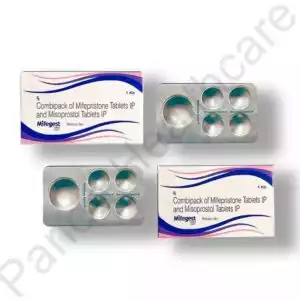
Understanding Medical Abortion. Medical Abortion Consultation Pharmacy
A Brief History
In the early 1980s, there were limited options for abortion methods, and the question of how to terminate a pregnancy typically had only one answer — surgical abortion or “purge,” as it was commonly known. The idea of a safe and effective method like Medical Abortion, often referred to as “Abortion Pills,” was still a dream for gynecologists at that time.
In the 1990s, a new technology called Manual Vacuum Aspiration (MVA), also known as “mini-abortion,” was introduced into obstetric practice. This provided women with a choice between surgical abortion and a relatively safe technique called vacuum aspiration, which was used when the gestational age allowed for a “mini abortion.”
Around the same time, Medical Abortion (MTP) was being developed and introduced in Western Europe. This method allowed women to terminate pregnancies without undergoing any instrumental manipulation of the uterus. The development of the anti-gestagen RU486 (Mifepristone) by French scientists made Medical Abortion highly effective. This breakthrough discovery has a fascinating history, which you can read about here. (Medical Abortion vs. Surgical Abortion: Understanding the Differences)
Definition of Medical Abortion
Medical Abortion is a voluntary termination of pregnancy achieved through medication use, commonly known as Abortion Pills. You can find more information about MTP on the Wikipedia page on Medical Abortion.
The pill abortion method has gained rapid popularity, not only in Europe but also in the United States. For example, over 80 percent of women in France who have chosen abortion at home have used this method.
MTP is the most modern and safest method for addressing early unwanted pregnancies. The two medicines used for this procedure are Mifepristone and Misoprostol, which should be used strictly according to the Instructions for Mifepristone and Misoprostol use.
Frequent Use of Abortion Pills
Over 250 million women worldwide have used Abortion Pills with Mifepristone and Misoprostol. This means there is a wealth of clinical experience with the combination of anti-gestagen and prostaglandin, which has proven to be very effective (93-95%) and safe (less than 7% for complications and side effects).
If you choose to have such a procedure, you can use our products and follow our recommendations. Our high-quality products are often more efficient than the stated values, and severe side effects are rare.
Description of Medical Abortion
An abortion clinical course consists of two phases (not to be confused with the drug administration stages — first stage and second stage):
The first phase of a medical abortion is the embryo expulsion phase. During this phase, the medications are taken, which work to end the pregnancy by causing the uterus to contract and expel the embryo. This process is similar to a miscarriage and can involve cramping and bleeding.
The second phase is the recovery phase. After the embryo has been expelled, the body goes through a recovery process. This phase may involve ongoing bleeding and cramping, but it gradually subsides over time. It is essential to follow the post-abortion care instructions provided by your healthcare provider to ensure a smooth recovery. During the first phase of the procedure, the fertilized egg is expelled from the uterine cavity. In the second phase, the body goes through a recovery process. Let’s take a closer look at each step.
1. Expulsion Phase
In the expulsion phase of Medical Abortion, the medications cause the release of the conception gestational sac or products of conception. This phase typically starts with cramping-like pain in the lower abdomen, followed by bloody discharge. In some cases, bleeding may occur before the pain, or the pain may not be subjectively felt. The duration of this phase varies from person to person, but it usually lasts for 2–3 days.
The expulsion phase concludes with the fetus and its membranes being expelled from the uterine cavity. This typically accompanies a reduction or cessation of pain, and the bleeding volume significantly decreases.
Two medications, Mifepristone and Misoprostol, are used during the expulsion phase. The specific drug regimen can be found in the Instructions for Mifepristone and Misoprostol use.
Mifepristone, the first medication taken, interrupts the development of the fetus. Women typically do not feel any immediate effects after taking the first medicine, which is normal.
The second medication, misoprostol, is taken after 36–48 hours. This medication induces uterine contractions, which expel the fetus from the uterine cavity. Symptoms such as pain and bleeding typically appear after taking Misoprostol in about 85% of cases.
Now, let’s explore the specific effects of each medication separately.
Effects of Mifepristone
Mifepristone primarily works by blocking progesterone at the receptor level in the uterus. Progesterone is the primary hormone responsible for maintaining pregnancy and promoting its development. When progesterone is blocked, it stimulates the contractile activity of the uterine muscular layer called the myometrium. This leads to an increase in uterine tone and activates the sensitivity to prostaglandins. The second drug in the regimen, Misoprostol, is a prostaglandin. By taking Mifepristone and Misoprostol together, the action of Mifepristone also increases the uterus’s sensitivity to Misoprostol.
Effects of Misoprostol
Misoprostol represents prostaglandins, specifically PGE, and has various effects. However, the main beneficial effect of this method is its ability to induce smooth muscle contraction and dilation of the cervix uterine, leading to the expulsion of the fetal egg from the uterine cavity, thereby completing the abortion process.
2. Recovery Phase
This phase involves all organs and systems working to return to the state before pregnancy. In uncomplicated Medical Abortion cases, rehabilitation or special therapeutic treatment is not required.
Pain in Medical Abortion:
Understanding the Experience and Managing Discomfort
Our products
Abortion Pill
Buy Abortion Pill online the UK or Europe, and the US
Abortion Pill contains 5 tablets: 1 Mifepristone tablet by 200 mg with 4 Misoprostol tablets by 200 mcg. It's convenient till 11 gestational weeks.
AntiPREG Kit
Buy Abortion Pills online in the US, Europe, Worldwide
AntiPREG Kit includes Mifepristone 200mg and Misoprostol 800mcg.
This should take up to 77 days or 11 pregnancy weeks
Abortion Pill Kit
Buy Abortion Pill Kit online in the US, Europe, and Worldwide
Abortion Pill Kit contains 5 tablets: 1 Mifepristone tablet by 200mg with 4 Misoprostol tablets by 200mcg. It's convenient till 11 gestational weeks
Cytolog
Buy Cytolog online in the US, Europe, and Worldwide
Cytolog contains 8 tablets: 2*4 Misoprostol tablets by 200mcg
Cytotec
Buy Cytotec online in the US, Europe, and Worldwide
Cytotec contains 8 tablets: 2*4 Misoprostol tablets by 200mcg
Generic RU-486
Buy Generic RU-486 online in the US, Europe, Worldwide
Generic RU-486 contains 10 tablets: 10 Mifepristone tablets by 25mg. Total 250mg
Medabon
Buy Medabon online in the US, Europe, Worldwide
Medabon contains 5 tablets: 1 Mifepristone tablet by 200mg with 4 Misoprostol tablets by 200mcg. It's convenient till 11 gestational weeks
Mifegymiso
Buy Mifegymiso online in the US, Europe, and Worldwide
Mifegymiso contains 5 tablets: 1 Mifepristone tablet by 200 mg with 4 Misoprostol tablets by 200mcg. It's convenient till 11 gestational weeks.
Mifegyne
Buy Mifegyne online in the US, Europe, and Worldwide
Mifegyne contains 10 tablets: 10 Mifepristone tablets by 25 mg. Total 250 mg.
Advantages of Medical Abortion and Disadvantages of Other Pregnancy Termination Methods
MTP is currently considered the safest method for terminating a pregnancy. But what are the other advantages of this method? And what are the disadvantages of alternative methods? You can find the answers to these questions in the advantages and weaknesses of the Medical Abortion section.
Duration of Medical Abortion: Obstetric and True Gestational Age
This subsection focuses on a critical point for abortions: how long can a woman terminate a pregnancy using different methods, especially non-surgical abortion? What is the maximum period for medical termination of pregnancy for medical or social reasons? How is gestational age calculated, and how does the obstetric term differ from the true one? You can find the answers to these questions in the maximum terms for Abortion—obstetrical and gestational pregnancy age section.
Contraindications for Medical Termination of Pregnancy (MTP)
Pharmaceutical Abortion, like any other medical intervention, has its contraindications that every woman should be aware of before undergoing the procedure. You can read about the contraindications for Medical Abortion in this section.
Prohibited Activities During and After a Medical Abortion Procedure
Many questions arise regarding what can and cannot be done during a medication abortion. Can you drink alcohol or smoke while undergoing a MTP? Is sex prohibited during the procedure? Which painkillers are safe to take? You can find answers to these and many other questions in the What is forbidden in the Medical Abortion section.
Smoking and Alcohol during Medical Abortion
For information on restrictions regarding smoking and alcohol intake during the medical termination of pregnancy, you can refer to the Smoking and Alcohol in Medical Abortion section.
Complications of Pregnancy Medical Termination
Medical Abortion is considered the safest method for terminating a pregnancy. However, as with any abortion procedure, there may be complications. What should you expect and be aware of during a Medical Abortion? What is the frequency and probability of unfavorable outcomes? And what should be done in each case? You can find the answers to these questions in the Possible Complications of Medical Abortion section.
Bleeding during a Medical Abortion and its Duration
After taking Misoprostol, what kind of discharge is normal? Does discharge start after taking Mifepristone? How long does the discharge usually last? How much discharge is typical? If the smearing discharge lasts for over a week, is that normal? You can find answers to these questions and more in the article on Bleeding in Medical Abortion.
What Kind of Pain is Experienced During a Medical Abortion, and How Long Does it Last?
What type of pain typically occurs during a Medical Abortion? How severe is the pain? If the pain is severe, what should be done? When does the pain usually start? How long does it typically last? These questions are addressed in the articles on Pain in Medical Abortion.
Body Temperature After a Medical Abortion
What is considered an average body temperature after a Medical Abortion? How long can a moderate temperature last? What should be done if the temperature rises? (Temperature in Medical Abortion).
Menstruation (Periods) After Pregnancy Termination and Possible Delays
When should menstruation occur after a Medical Abortion? What should be done if menstruation is delayed? Find answers to these questions and more in the article on Menses after Medical Abortion.
Getting Pregnant After a Medical Abortion
What is the impact of a Medical Abortion on subsequent pregnancies? Find information on the risks of a new pregnancy and the optimal time to plan for pregnancy in the article on Pregnancy after Medical Abortion.
Breast Changes After a Medical Abortion and Its Impact on Breastfeeding
How do changes in the mammary glands (breasts) occur during pregnancy and after an abortion? What are the possible complications and risks after an abortion? What should nursing mothers do? How soon after a Medical Abortion can breastfeeding be resumed? Find the answers to these questions in the article on Breast and Medical Abortion.
Examination After a Medical Abortion
What should be done after a Medical Abortion procedure? What medical tests need to be conducted? How can one ensure that everything went well and there were no complications? Find the answers to these questions in the article on Examination after Medical Abortion.
Sex After a Medical Abortion
Is sex prohibited during and after a Medical Abortion? What are the restrictions on sexual activity, and when can one resume it? Learn more about this topic in the article on Sex and Medical Abortion.
Contraception After a Medical Abortion
Is contraception necessary after an abortion? What are the best methods of contraception, and when should I start? You can find all the details about using birth control methods in the article on Contraception after a Medical Abortion.
What Should I do If I Have an Incomplete Abortion (If the Pregnancy Persists)?
What should be done in the case of a complication such as “incomplete abortion”? What methods are used for pregnancy termination in this situation? Learn more about it in the article on Incomplete Abortion.
Late-term Abortion
From which week of pregnancy is it considered late-term? What should be done if there is a need for pregnancy termination at a later stage? Find answers to these questions in the article on Late-term Abortion.
Abortion in the First Pregnancy
Is it dangerous to terminate the first pregnancy, and what complications are possible in this situation? Learn about the methods available for completing a first pregnancy in the article on Abortion in the First Pregnancy.
Depression After an Abortion. Post-abortion Syndrome (PAS)
A detailed description of the specific pathologies associated with pregnancy termination and their impact on the central nervous system. Read more about depression after an MTP in the article on Depression after Medical Abortion.
This concludes the information on Medical Abortion.
You can purchase Abortion Pills of the highest quality for pregnancy termination from our online pharmacy. Moreover, each client receives professional consultation from a gynecologist throughout the procedure.
Author
 Dr. Kopp Kallner. M.D. in Obstetrics & Gynecology, Columbia University Medical School.
Dr. Kopp Kallner. M.D. in Obstetrics & Gynecology, Columbia University Medical School.
Buy Abortion Pills

 Français
Français Deutsch
Deutsch Español
Español Русский
Русский








